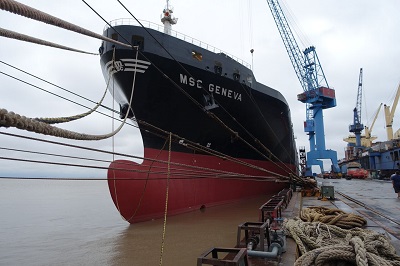First Widened Container Ship Enters Service
After a successful sea trial, the world’s first widened container ship has entered service sailing between China and South America. The ship, managed by German ship manager Reederei NSB reentered liner service for MSC on July 1.
The conversion is expected to enhance the competitive edge of the Panamax container vessel by increasing operational efficiency and improving its carbon footprint.
.jpg) The widening service is also offered to other shipowners and ship managers by NSB’s subsidiary NSB Marine Solutions, and the demand for future widening projects has been rising.
The widening service is also offered to other shipowners and ship managers by NSB’s subsidiary NSB Marine Solutions, and the demand for future widening projects has been rising.
On July 1 the MSC Geneva re-entered service, called Chiwan, and will then operate on liner service, sailing the Pacific Ocean between Asia and South America.
On June 18, NSB and its partners Huarun Dadong Shipyard (HRDD) and Technolog GmbH celebrated the world premiere of the vessel.
“No one has ever cut a container ship longitudinally from the superstructure to the bow to widen it,” says Tim Ponath, Chief Operative Officer of Reederei NSB. “We are very proud of our team who widened the MSC Geneva and thus demonstrated the viability of our concept. The ship will prove that it can keep up with the other carriers that ply the world’s oceans.”
“With this project NSB has solidified its excellent global reputation as a leading ship manager with a vision and pioneering spirit,” said Jifeng Wu, Managing Director of HRDD shipyard. “It has successfully upgraded one of three of its ships through widening, managed to enhance the competitiveness of Panamax vessels and improve the overall economic framework.”
 Developments in container ship building are extremely fast, says Ponath. Panamax vessels delivered after 2004 are no longer competitive today. They may even have to be scrapped at high cost before their expected lifespan is up. Reederei NSB’S innovative widening concept makes older container ships more competitive.
Developments in container ship building are extremely fast, says Ponath. Panamax vessels delivered after 2004 are no longer competitive today. They may even have to be scrapped at high cost before their expected lifespan is up. Reederei NSB’S innovative widening concept makes older container ships more competitive.
Depending on the ship type, the conversion adds up to four container rows to the ship, increasing the load-carrying capacity by about 30 percent. Instead of 4,872 containers, a widened ship can load 6,336 boxes. Apart from the load-carrying capacity, the conversion also increases the ship’s transverse stability. On top, less ballast water is needed.
The widening also improves the energy efficiency of the ship: carbon emissions per ton of cargo are significantly lower. The IMO Energy Efficiency Design Index, which will apply from 2025 onward, achieved by widened ships equals that of newbuildings.
